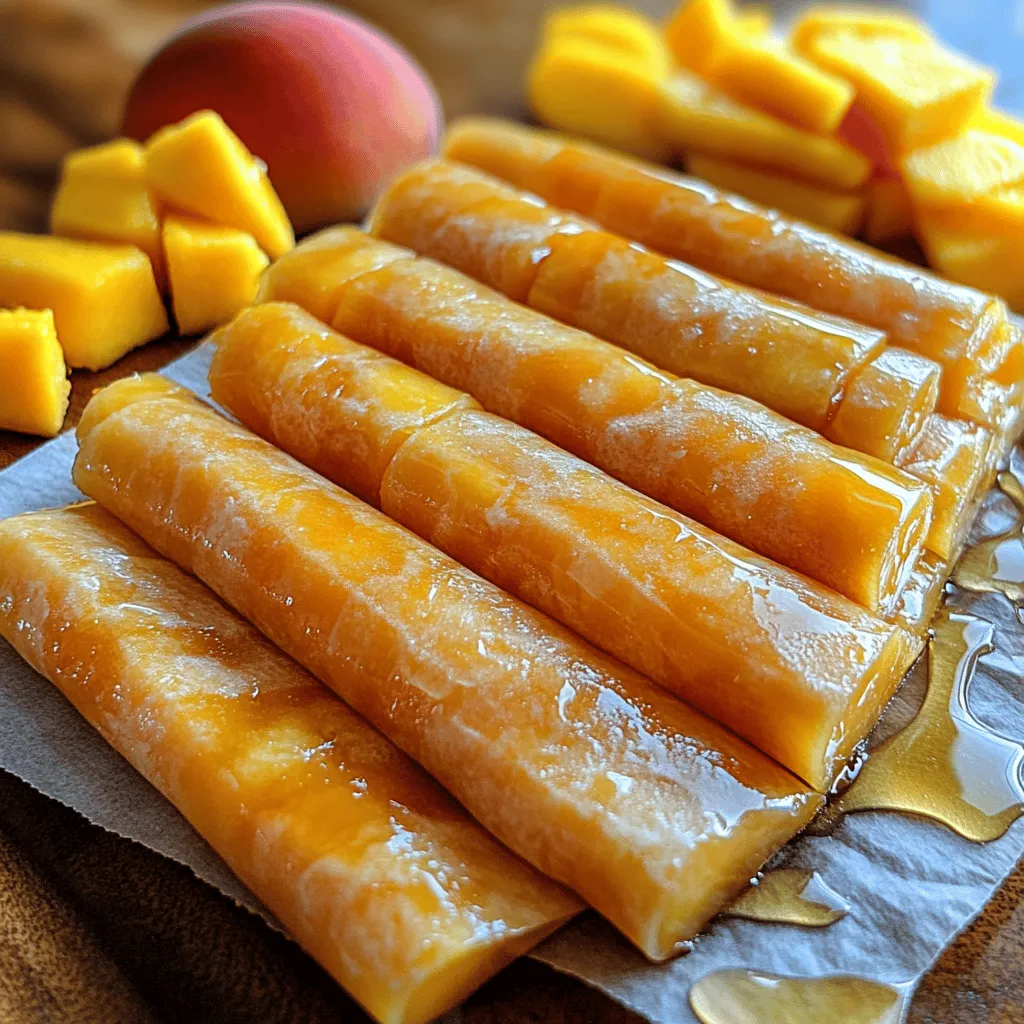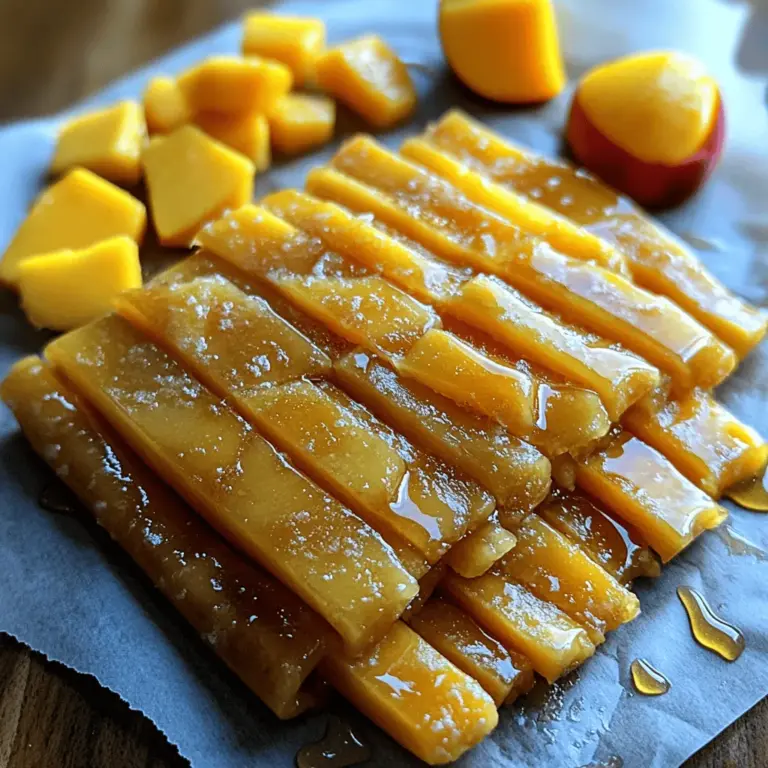Introduction
In today’s health-conscious world, snacks that are both tasty and nutritious are in high demand. One delightful option that has gained popularity is fruit leather, a chewy, flavorful snack made from pureed fruit. Not only is fruit leather a healthy alternative to sugary, processed snacks, but it also offers the chance to enjoy the vivid flavors of fresh fruits in a convenient form. Among the myriad of fruit leather recipes, the Tropical Bliss Fruit Leather stands out with its vibrant combination of mangoes and peaches, transporting your taste buds straight to a sunny paradise.
This recipe for Tropical Bliss Fruit Leather is not just about indulging in tropical flavors; it’s also about celebrating the natural sweetness and health benefits of ripe fruits. By making fruit leather at home, you gain complete control over the ingredients, allowing you to customize flavors to your liking while avoiding additives and preservatives found in many store-bought snacks. Whether you are looking for a quick on-the-go snack for yourself or a healthy treat for your kids, this homemade fruit leather is a fantastic choice.
Understanding Fruit Leather
Fruit leather, often called fruit roll-ups, is essentially a concentrated, chewy version of fruit puree. The history of fruit leather dates back centuries, with various cultures around the world using different methods to preserve fruits. From the ancient Greeks and Romans who dried fruits in the sun to the modern-day methods using dehydrators and ovens, this snack has evolved into a beloved treat that bridges generations.
When it comes to nutritional benefits, homemade fruit leather excels compared to its commercial counterparts. Store-bought fruit leathers often contain added sugars, artificial flavors, and preservatives that can compromise health benefits. In contrast, by making fruit leather at home, you can harness the full nutritional profile of the fruits used. For instance, mangoes are rich in vitamins A and C, while peaches provide a good source of vitamins C and E, fiber, and a variety of antioxidants.
For optimal flavor and texture, it is crucial to use ripe, fresh fruits. Not only will they ensure the best taste, but they will also provide the necessary natural sweetness that makes fruit leather so enjoyable. The sweetness of ripe fruits can be further enhanced with a touch of honey or maple syrup, balancing out the flavors and creating a deliciously satisfying snack.
Ingredients Breakdown
Creating the Tropical Bliss Fruit Leather involves a harmonious blend of simple, natural ingredients. Below is a detailed look at each component that contributes to this delightful snack:
– Ripe Mangoes: Mangoes are often referred to as the “king of fruits,” and for good reason. Not only are they sweet and juicy, but they are also packed with essential nutrients. A medium-sized mango typically contains about 150 calories and is a rich source of vitamin C, vitamin A, and dietary fiber. Their tropical flavor contributes a luscious base to the fruit leather, making it both delicious and nutritious.
– Ripe Peaches: Peaches complement mangoes beautifully, adding a touch of floral sweetness and a soft texture. These stone fruits are low in calories but high in vitamins, particularly vitamin C and vitamin A, as well as other antioxidants that promote skin health and digestion. The combination of peaches and mangoes creates a balanced flavor profile that enhances the overall taste of the fruit leather.
– Honey vs. Maple Syrup: When sweetening your fruit leather, you have the option of choosing between honey and maple syrup. Both natural sweeteners have their unique qualities. Honey, with its floral notes, can enhance the fruit’s flavor but is not suitable for vegans. On the other hand, maple syrup offers a rich, earthy sweetness and is a great alternative for those avoiding animal products. Depending on your dietary needs and taste preferences, you can choose the sweetener that best suits your recipe.
– Lemon Juice: A splash of lemon juice serves multiple purposes in this recipe. Firstly, it provides a refreshing acidity that balances out the sweetness of the fruits. Secondly, lemon juice acts as a natural preservative, helping to maintain the vibrant color and freshness of the fruit leather. The acidity also enhances the overall flavor profile, making each bite more delightful.
– Ground Ginger: While optional, ground ginger can add a unique warmth and spice to the fruit leather. Known for its anti-inflammatory properties and digestive benefits, ginger complements the tropical flavors beautifully. If you’re a fan of a little zing in your snacks, consider adding a teaspoon of ground ginger to elevate the taste.
– Salt: A pinch of salt may seem insignificant, but it plays a vital role in enhancing the sweetness of the fruit. Salt helps to balance flavors, making the fruit leather taste more intense and satisfying. Just a small amount can elevate the overall experience of this chewy treat.
Preparation Steps for Tropical Bliss Fruit Leather
Now that you have a good understanding of the ingredients, it’s time to dive into the preparation process for your Tropical Bliss Fruit Leather. Here’s a step-by-step guide to help you create this delicious snack:
Selecting and Preparing Ripe Mangoes and Peaches
The first step in preparing your fruit leather is to select the best mangoes and peaches. Look for fruits that are slightly soft to the touch and have a pleasant aroma, indicating ripeness.
1. Mangoes: Start by peeling the ripe mangoes and removing the pit. Cut the mango flesh into chunks for easier blending.
2. Peaches: Similarly, wash the peaches thoroughly, remove the pits, and chop them into small pieces. If you prefer, you can peel the peaches, but leaving the skin on adds additional fiber and nutrients.
Blending Tips for Achieving the Desired Consistency
Once you have your fruits prepared, it’s time to blend them into a smooth puree:
1. Combine the Fruits: Add the chopped mangoes and peaches into a blender or food processor.
2. Blending: Blend until you achieve a smooth consistency. Depending on your blender, this may take a minute or two. If necessary, stop occasionally to scrape down the sides to ensure all fruit is blended evenly.
3. Adjusting Thickness: If the mixture seems too thick, you can add a tablespoon of water or more lemon juice to help it blend smoothly.
Discussing the Sweetening Process
After achieving the desired fruit puree consistency, it’s time to sweeten it according to your taste:
1. Sweetening: Start by adding honey or maple syrup to the fruit puree. A good starting point is about 2-4 tablespoons, but this can be adjusted based on your preferences and the natural sweetness of the fruits.
2. Taste Test: Blend the mixture again and taste to see if it meets your sweetness preference. Keep in mind that the sweetness will intensify slightly as it dehydrates, so it’s okay for it to be a bit less sweet than you desire.
3. Balancing Flavors: Add the lemon juice and a pinch of salt to the mixture, blending once more to combine all ingredients thoroughly. Taste again and adjust the sweetness or acidity if necessary.
Importance of Using Parchment Paper or Silicone Mats in Preparation
Once you have your fruit puree ready, it’s essential to prepare your drying surface:
1. Choosing Your Surface: You can either use a dehydrator or an oven to dry your fruit leather. For both methods, choose parchment paper or silicone mats to line your trays or baking sheets. This prevents sticking and makes it easier to peel the fruit leather once it’s dried.
2. Spreading the Mixture: Pour the fruit puree onto your lined trays, spreading it evenly with a spatula to about 1/8 to 1/4 inch thick. A uniform thickness ensures even drying.
Dehydration Process
The dehydration process is critical for achieving that perfect chewy texture in your Tropical Bliss Fruit Leather. Depending on whether you use a dehydrator or an oven, the drying times may vary.
1. Using a Dehydrator: Set your dehydrator to 135°F (57°C) and dry for about 6 to 8 hours. Check the leather periodically for doneness; it should be flexible but not sticky to the touch.
2. Using an Oven: If you opt for the oven, preheat it to the lowest setting (usually around 170°F or 77°C). Place the trays in the oven and leave the door slightly ajar to allow moisture to escape. The drying process may take anywhere from 4 to 8 hours, so keep an eye on it as it gets close to the finish line.
By following these steps and tips, you’ll be well on your way to creating your very own Tropical Bliss Fruit Leather, a flavorful and nutritious snack that can be enjoyed by the whole family. Stay tuned for the next part, where we will delve into finishing touches, storage tips, and more delightful variations to elevate your fruit leather experience.


